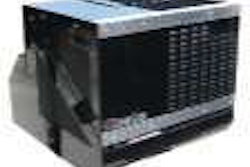Efficiency is Precedent at Thermo King
New reefer embodies today’s business world
The trucking business is changing. Everything changes over time, of course, but the trucking industry has been remarkably resistant to change over its 100-year-plus history.
The most recent trend I’ve seen is the movement toward greater efficiency. For a long time, efficiency wasn’t a critical component of trucking operations, due mostly to some good fortune on the part of the American economy: Fuel was dirt-cheap, drivers were plentiful, regulations were comparatively mild and trucking technology was both robust and affordable. Most fleets made money, and efficient fleets made more money.
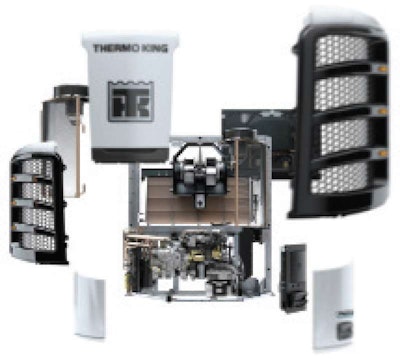 The Thermo King Precedent trailer temperature control platform is designed to be fully compliant with the U.S. Environmental Protection Agency’s new Tier IV final regulations.
The Thermo King Precedent trailer temperature control platform is designed to be fully compliant with the U.S. Environmental Protection Agency’s new Tier IV final regulations.Today, efficiency drives every aspect of a trucking operation. Our industry has become a game of pennies and even partial pennies. If you can find a way to add .04 mpg to your fleet operation, your boss will be ecstatic.
Efficiency is essential for competing in today’s marketplace, complying with a wide range of state and federal regulations and – perhaps most importantly – allowing your business to survive in a turbulent, unpredictable business environment.
Those tenets were driven home to me during a recent visit to Thermo King’s headquarters in Bloomington, Minn. When it comes to auxiliary power unit and reefer technology, Thermo King is one of the most forward-thinking companies I’ve come across. They have to be; just like you, they’re driven by good competition, ever-changing government regulations and a rock-solid belief that system efficiency is vital to the success of their products.
The platform sets new standards in both fuel efficiency and cleaner emissions.
Thermo King’s newest temperature control system, the Precedent refrigerated trailer unit, is a perfect example of this thinking. Thermo King president Ray Pittard says the Precedent is a game-changer for both his company and the refrigerated food industry as a whole.
“We have invested $60 million in this new product,” Pittard says. “It is one of the largest – if not the largest – product developments in the history of Ingersoll-Rand.”
More efficiency: The trucking industry is a game of pennies.
Big investment: Thermo King invested $60 million in the Precedent.
Many innovations: The company calls the new system a game-changer.
Tom Kampf, trailer product manager for Thermo King, describes the Precedent platform as an entirely new design with stated and accomplished goals of setting new standards in both fuel efficiency and clean exhaust emissions.
Key to this approach was developing a new Thermo King-exclusive Diesel DirectElectric powertrain architecture that Kampf says delivers optimal efficiencies in temperature control, along with double-digit fuel savings in real-world operations. According to Kampf, customers typically will see refrigerated unit fuel savings of 11 percent, with savings of up to 19 percent in certain applications. That’s big news in an industry that thrives on pennies saved.
Both S-Series models feature a new fuel injection system that Kampf says delivers optimized combustion to tightly control particulate matter in the engine cylinders, eliminating the need for diesel particulate filters and selective catalytic reduction systems.
A new belt-driven permanent magnet generator allows the engine to be matched optimally to the system compressor and generator to deliver maximum cooling efficiency. At the same time, dual electronically controlled condenser fans allow the Precedent units to manage engine load over a wide range of operating conditions.
The Precedent units are six inches wider than current Thermo King models to accommodate a full-width evaporator that provides maximum coil surface area, while a centralized air discharge system ensures optimal delivery of cooled air to the trailer. A new SR4 control system has been designed with an easier human-to-machine interface to make programming and operating the units simpler and more efficient.
And as I said, efficiency is the name of the game today. Isn’t it?

JACK ROBERTS is Executive Editor of Commercial Carrier Journal. E-mail [email protected] or call (205) 248-1358.
Kenworth spotlights natural gas efforts
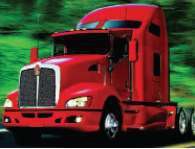 The new Cummins ISX12G 12-liter natural gas engine initially will be offered in the Kenworth T660 in early 2013.
The new Cummins ISX12G 12-liter natural gas engine initially will be offered in the Kenworth T660 in early 2013.At a press briefing at its corporate headquarters in Renton, Wash., Kenworth officials detailed their efforts to prepare for a major heavy-duty natural gas push beginning next year. The company’s natural gas offerings, which already span three engine choices in six different vehicle platforms, will receive an additional boost when Kenworth is one of the first truck manufacturers to receive the new Cummins ISX12G 12-liter natural gas engine in early 2013.
The new engine initially will be offered in the Kenworth T660. Andy Douglas, national sales manager, specialty trucks, said the new engine has been in verification testing for more than a year and already has logged more than 2 million test miles.
Bridgestone cites value of Ecopia-FuelTech combo
Bridgestone officials said during a press briefing last month that the company’s new Ecopia tires and complementary Bandag FuelTech retreads provide added value over the tires’ 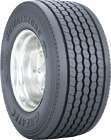
“We don’t just keep in mind the original wear performance of the new tire,” Damon said. “We want to make sure that tire will be retreaded two to three times with the same rolling-resistance benefit.”
Navistar devises post-EGR plan, looks toward the future
Company talks new engine strategy, restoring confidence, profitability
By Jack Roberts
Navistar says it is hitting the “reset” button.
After years spent developing and marketing its own engine platform, a series of negative turns this year resulted in an about-face on Navistar’s engine technology and a nosedive in its stock price. Now, executives say, they are charging ahead with a new engine strategy and a plan to restore customers’ and investors’ confidence in Navistar’s products and return the company to profitability.
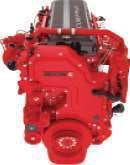 Navistar will offer the Cummins ISX15 in International ProStar+ tractors beginning in January, with an EPA-certified MaxxForce 13 – with ICT+ exhaust aftertreatment, Navistar’s SCR technology – appearing in March.
Navistar will offer the Cummins ISX15 in International ProStar+ tractors beginning in January, with an EPA-certified MaxxForce 13 – with ICT+ exhaust aftertreatment, Navistar’s SCR technology – appearing in March.“We really feel like our competitors are telling our story instead of us, and we want to change that,” said Jack Allen, North American Truck Group president for Navistar, during a meeting last month at Navistar’s headquarters in Lisle, Ill., with editors from Randall-Reilly Publishing Co., owner of CCJ and Overdrive magazines.
Allen said the controversial push to meet 2010 emissions standards using an exhaust gas recirculation-only engine, as opposed to one using selective catalytic reduction, was rooted in the pride Navistar takes in understanding its customers. “More than 9,000 fleets went out of business during the economic crash, while government regulations such as HOS (hours of service), CSA (Compliance Safety Accountability) as well as rising fuel prices have created big challenges for them,” he explained. “We really thought an engine without SCR would be a big help to them.”
Every other diesel engine manufacturer ruled out an EGR-only engine as impractical for meeting 2010 standards set by the U.S. Environmental Protection Agency. But Allen said Navistar felt their engineers could develop one, which would give the company a huge advantage for years.
“So we started early back in 2000 building engines that allowed us to stockpile credits because we knew we’d have a race against time on our hands to get to the EPA’s 2010 NOx requirement of .2 grams before those credits expired,” Allen explained. “And it really surprised us how loud our competition screamed about our efforts.”
In the end, “Our EPA credits ran out before we could get the technology perfected,” he said. “The angst in the marketplace was starting to become overwhelming. So we’re going to move forward.”
As previously announced, that means offering the Cummins ISX15 in International ProStar+ tractors beginning in January, with an EPA-certified MaxxForce 13 – with ICT+ exhaust aftertreatment, Navistar’s SCR technology – appearing in March. Until then, the company will continue to sell EGR-only MaxxForce 13 engines and pay an EPA noncompliance penalty for each one sold. A final EPA ruling as to the amount of the NCPs per engine is expected in 30 to 60 days. The announcement also said that Navistar would adopt a proprietary SCR system based on Cummins’ exhaust aftertreatment systems.
A federal appeals court decision ruled that EPA did not follow proper procedures in assessing NCPs to the MaxxForce 13 engines. The ruling also said that initial NCPs of $1,200 per engine were insufficient punishment and created an unfair advantage for Navistar over competitive companies that invested in SCR technology.
The court decision intensified the industry spotlight on Navistar’s struggle to develop an EGR-only emissions solution as well as the company’s ability to continue selling noncompliant engines. Additionally, reports of reliability issues with MaxxForce-equipped trucks and questions about the value of MaxxForce-equipped used trucks led Navistar’s stock price to drop from $47.42 a share in February to $24.75 by mid-August.
Prior to the decision, Navistar’s EGR-only project had devolved into a bitter war of words and lawsuits against competitors, the California Air Resources Board, EPA and even customers as the company struggled to perfect its emissions solutions before EPA credits expired. The fallout left Navistar battered and the North American trucking industry awash with rumors of unreliable engines and angry dealers and customers. Mainstream reporters in recent months questioned the company’s long-term cash-flow situation and viability and reported on shareholder efforts to remove top Navistar officials. There has been speculation that an acquisition by foreign automakers or full-blown bankruptcy are likely outcomes.
Allen and other Navistar officials expect nothing like that, now that their new strategy is in place. Customers should not be hesitant to purchase an EGR-only MaxxForce-equipped truck between now and March, Allen said. And likewise, he predicted concerns over the resale value of EGR-only MaxxForce-equipped trucks will prove to be temporary.
“The judge didn’t void the trucks,” Allen said of the recent appellate court ruling. “Check out the Website about trucks sold under interim rule. Nothing will happen. And as for used truck values? We feel the secondary market will be very receptive to a truck built without SCR. Our MaxxForce fuel economy is great. Our performance is great. And we have more than 50,000 of those engines out there.”
Likewise, there should be no concerns about integration of the ISX15, said David Majors, vice president for North American product development. Majors said Cummins and Navistar engineers working at an International R&D center in Colorado took a Cummins ISX15 from a competitor’s truck, installed it in a ProStar+ and added a Cummins aftertreatment system in two days. “We can’t afford any more teething problems,” Majors conceded, referencing problems with MaxxForce reliability.
Tim Shick, vice president of North American engine sales, said those problems were a result of production ramp-up problems and not related to EGR or high engine temperatures as rumored. “Customer demand had increased greatly,” Shick said. “We were building 220 trucks per day. A lot of our big suppliers went to third shifts to keep up with demand.” Inexperienced employees led to problems with leaking EGR coolers and some valving issues, he said. “Those issues cleared up as more experienced employees taught the newer ones. And we are still replacing some of those parts.”
“Our strategy here is to get the Cummins ISX15 out there first,” Majors added. “It’s already proven from an EPA standpoint and will be offered in the ProStar+ with four ICT+ packaging options. We’ll add the MaxxForce 13 back into the mix in March, followed by full engine integration into ProStar, WorkStar, TranStar, finishing up with the 9900 and PayStar. We will be fully integrated throughout our model line with these new engines in 2013.”
The current plan leaves up in the air the status of the MaxxForce 15 diesel engine, which has not begun the certification process for EPA approval. “We haven’t made any final determination on that engine,” Allen said.
The time and money poured into the EGR-only technology wasn’t wasted, Allen stressed. “We don’t lose anything from the in-cylinder standpoint. We learned a lot about the different levels of EGR. And we feel we can combine that knowledge with proven Cummins aftertreatment systems and have a winning engine with a winning emissions solution.”
This approach will give Navistar customers “the best of both worlds” in terms of diesel engine technology, said Shick. “Most of our base engine components are the same,” he explained. “This includes the entire EGR system, the fuel system and the turbocharger – only now we’re adding a NOx sensor and Cummins aftertreatment. So our efforts are directed at adjusting our combustion chemistry – making our exhaust more similar to what the Cummins aftertreatment system is used to seeing.”
And while the return of Cummins power to its heavy-duty lineup will provide Navistar with much-needed stability in the volatile months ahead, the question remains of how the move will be received by Caterpillar and its new CT660 heavy-duty truck, which is built by Navistar. When asked if Caterpillar would assent to Cummins power, Shick was noncommittal. “Surprisingly, their first response was not, ‘Hell no!’,” he said. “Over the next 30 to 60 days, we’ll have an answer on whether it’s our 15L or Cummins. In the interim, we have the 13L, and that’s been working for them.”
Navistar’s EGR research gives the company a “huge” advantage in terms of enhancing SCR, Majors said, and eventually will yield a superior heavy-duty engine offering. “Fuel economy and performance will be improved over time as we get comfortable with SCR and dial back the amount of EGR in the combustion chamber,” he said. “But for now, the emphasis is on getting the engine certified and soothing the angst that is out there.”
Meritor WABCO develops ‘smart’ ESC
Company upgrades collision safety system
Meritor WABCO, a provider of integrated safety systems and efficiency components for the North American commercial vehicle industry, introduced ESCsmart technology designed to help advance the performance, functionality and flexibility of its Electronic Stability Control safety system.
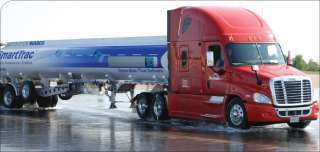 Meritor WABCO’s improved OnGuard collision safety system will be available on every vehicle ordered with OnGuard after Oct. 1.
Meritor WABCO’s improved OnGuard collision safety system will be available on every vehicle ordered with OnGuard after Oct. 1.ESCsmart, to be included in Meritor WABCO’s next-generation ESC when it is released in 2014, builds upon the current “self-learning” capability whereby the system is designed to automatically adapt to changes in vehicle characteristics and wear without the need to reprogram a separate electronic control unit.
“ESCsmart is a significant step in the evolution of electronic stability control,” said Jon Morrison, president and general manager, Meritor WABCO. “Fleets can reduce downtime due to the need for reprogramming the ECU every time they have a truck and/or trailer configuration change.”
Meritor WABCO also introduced the next generation of its OnGuard collision safety system, featuring advancements in its radar-based technology. The improved OnGuard system – which integrates collision warning, adaptive cruise with active braking and collision mitigation – will be available on every vehicle ordered with OnGuard after Oct. 1.
The system, which features improved object tracking performance and immediately available stationary object warning capability, also is designed to integrate stationary object braking capability in the near future.
Meritor WABCO also announced that its Electronically Controlled Air Suspension will be available in September to the North American market, and that its next-generation Lane Departure Warning system – including the SafeTraK technology by Takata Corp. – will be available for fleet installation starting in October this year.
DTNA showcases Cascadia Evolution with DT12 transmission
Integrated powertrain maximizes fuel efficiency, safety
Last October, Daimler Trucks North America spoke for the first time about its plans for a vertically integrated powertrain using proprietary components from Detroit Diesel Corp. The company followed through with the introduction of its Detroit axle line in January and completed the powertrain rollout by announcing its DT12 transmission in March.
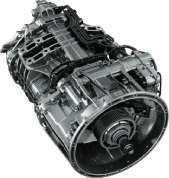 Available in direct-drive and overdrive, the DT12 automated manual transmission will be in production in May 2013.
Available in direct-drive and overdrive, the DT12 automated manual transmission will be in production in May 2013.At an August press event in Napa, Calif., DTNA provided a hands-on demonstration of the new Freightliner Cascadia Evolution equipped with the 2014 DD15 engine paired with the new DT12 OA 2050 automated manual transmission. Available in direct-drive and overdrive, the DT12 will be in production in May 2013. A smaller DT12 OB 1650 to be paired with the DD13 will be available later that year.
Features of the DT12 are designed to maximize fuel efficiency and improve vehicle safety and performance. The 12-speed transmission weighs in at 789 pounds (the DT12 OB 1650 weighs 670 pounds) and combines a traditional manual gearbox with high-speed computer-controlled shift and clutch actuators that select shift pattern and clutch engagement automatically.
One way the DT12 maximizes fuel economy is its eCoast feature that places the DD15 engine in idle as the tractor coasts down grades while maintaining vehicle momentum. As the tractor slows, the transmission seamlessly kicks back into gear to maintain the desired speed. In a 2,500-mile test run from San Diego to Gastonia, N.C., the transmission’s eCoast was engaged for 650 miles of the journey.
Another fuel-saving feature of the DT12 is Skip Shift, a feature that lets the transmission run through lower gears more quickly by skipping gears and select shift points in order to achieve cruising speed sooner.
An advanced cruise control system features three levels: a low range that tops out vehicle speed at 3 mph over the set cruise speed, a medium range that increases vehicle speed by 6 mph, and a no-limit high range.
A “creep mode” simulates a torque converter to improve maneuverability at low speeds for heavy traffic, docking and parking applications. In addition, a hill start aid prevents rollback when starting from a stop on an incline.
The transmission is integrated with DTNA’s Virtual Technician: When the transmission light comes on, a fault code is sent to the Detroit Customer Support Center for analysis. The DT12 comes with a five-year 750,000-mile warranty and a two-year 250,000-mile warranty on the clutch – Jeff Crissey



